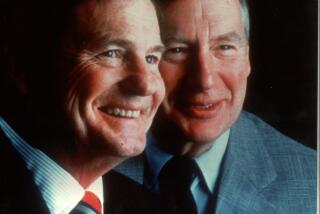PBS’ Horse-and-Buggy ‘Space Station’
- Share via
If you’re the kind of person who would look forward to back-to-back episodes of “This Old House,” then PBS’ documentary “Space Station” is for you.
“Space Station” takes us where man has gone many, many times before. And it does so with all the excitement of drying paint.
The problem is two-fold. First, Earth-orbit missions are so old-hat that people barely notice space shuttle flights anymore (and it’s a good thing for NASA, because the fleet is getting so old that shuttle launches are routinely postponed because of wiring or other hardware problems). Even the recently failed Mars Polar Lander was infinitely more riveting than any shuttle mission.
So a two-hour special on assembling a collection of modules in Earth orbit--despite some nifty navigation and repair work by shuttle astronauts--calls for an Oliver Stone or a Steven Spielberg to breathe some life into it. Unfortunately, neither was available.
This brings us to the second problem: the documentary itself. Director-producers Karl Sabbagh and Belinda Aird deliver a production so somnolent that the viewer feels he has sat through all 40 planned space station-assembly launches over the entire five-year period. Throw in the tranquilizing tones of narrator Peter Thomas, and you’ve got the makings of a good night’s sleep.
None of this is to say that the International Space Station is not a worthwhile project. Something like this may some day enable engineering and manufacturing feats that will not only help life on our planet but also hasten exploration of other worlds.
But this documentary rarely takes the long view. Instead, it favors the nuts-and-bolts approach (literally); it’s akin to telling the story of the Golden Gate Bridge through the eyes of a cement mixer or another subcontractor who worked on it without ever letting on how the finished bridge will change people’s lives.
The most intriguing part of “Space Station” lies not in the project’s technology--nothing revolutionary here; in fact, the computers being used on board the station are already obsolete (but still functional). Rather, it is in the strained, almost laughable relationship between the United States and Russia, the two primary international partners.
In the spirit of the worst of corner-cutting subcontractors you’d find in Jersey City, the Russians do such a shoddy job on the critical service module that the Americans tell them “no thanks,” and turn to the U.S. Navy to provide that piece of hardware. The Russians, despite severe economic problems, eventually redeem themselves and provide the module, but only after a blowhard U.S. congressman publicly humiliates a Russian official over the project.
Incompetence finds its way to America, as well. In 1997, NASA gave Boeing, the project’s primary contractor, a grade of zero out of 100 for its performance following nearly $200 million in cost overruns for the space station in 1996. Boeing bounced back with a grade of 70 in its next evaluation.
Where is Bob Vila when you need him?
*
* “Space Station” airs 9-11 tonight on KCET-TV.
More to Read
The complete guide to home viewing
Get Screen Gab for everything about the TV shows and streaming movies everyone’s talking about.
You may occasionally receive promotional content from the Los Angeles Times.






